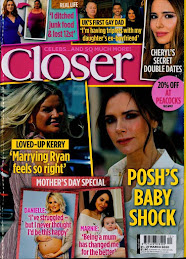Here are Thursday's lesson videos:
Representation:
Social and cultural contexts:
This was the Tuesday lesson video covering media language in Reveal:
The key notes on Reveal are here:
General
- According to publisher Hearst: "Reveal is the reader’s best friend: fun, gossipy and full of advice on everything from fashion and beauty to diets and cocktails. We know who's dating whom, who has fallen out with their best friend, whose relationship is in tatters and who's finding motherhood hard. Our high-street fashion is affordable…"
- However, Reveal closed in September 2018 after it stopped making a profit.
- Reveal’s tag-line was ‘Talking with you, not at you!” which implies that the magazine wanted to be seen as a friend to its readers, sharing secrets about the lives of famous celebrities. It was released weekly and cost 99p.
- The Editor claimed: ‘It delivers glamour, gossip and giggles’ which reinforces the magazine’s identity as a ‘girl’s best friend’.
- Star Appeal: The magazine consistently used images of celebrities - paparazzi shots as well as posed shots for authenticity.
- It focused on celebrity relationships and fashion and beauty tips for ‘every day’ women (for example testing high street brands which are more affordable for readers.)
- The magazine itself was affordable at only 99p so it wanted to maintain an audience who could afford to buy it regularly and whenever they see something eye-catching on the cover.
- The demographic who bought Reveal were mostly adult women, aged 18-34. Unlike Tatler, which is London and South of England-centric, Reveal was bought by women all over the country. Its readership also spanned a much wider set of social classes, from ABC1-C2DE. Psychographic groups for Reveal would largely have been strugglers or mainstreamers.
Media language
- Typography / Fonts: Sans serif fonts are used to make the magazine feel modern, informal and offering the latest gossip. Handwritten fonts are also used to make the magazine more personal – the reader’s ‘friend’.
- Cover lines: Indirect address favoured by celebrity gossip magazines so it seems like you have just seen them yourself – emphasises the gossip feel. Informal language ‘stuff the diet’ and ‘yay’ make this magazine youthful and accessible.
- Colour scheme: Red, yellow and pink. Bright colours to attract attention – important with no main central image. Gossip magazines tend to be busier and more packed with images to suggest issues that are bursting with different stories.
Representations
- The people represented on the cover are mostly celebrities and well known actors, reality television stars and music artists. Why?
- Celebrities are presented as important and desirable – but the photography is designed to make them look like ‘normal’ people.
Social and cultural contexts
The cover lines in Reveal focus on a few key areas:
- Domesticity and families: ‘baby bump’, ‘mum’
- Relationships: normative and subversive as words are used such as‘stalker’, ‘secret meetings’ and ‘sex’. Focus is on relationship breakdowns.
- Beauty: Diets and skin care are mentioned but these take into account ‘normal’ people since the focus is on previously thin celebrities giving up diets and enjoying treating themselves and, instead of promoting expensive products, the skin care is ‘one simple trick’.
- Advice: Socially, this magazine wants to be like a ‘friend’ in terms of gossip and advice. It also is keen to relate to its working class, mainstream audience and not alienate them by featuring unaffordable, luxury items.
Reveal: case study blog task
Work through the following tasks and questions to build a detailed case study for Reveal - 18 March 2017 (below). This will give you plenty of background information to use in an exam question on print magazines.
Media language
1) How many of the 12 magazine cover key conventions feature on this edition of Reveal? List them with specific reference to the convention on the CSP edition of Reveal.
2) What is the font choice used on the cover and what does this choice connote? Here's a blog to help you with this as we haven't been able to complete the Photoshop typography lesson yet due to Covid-19.
3) How do the cover lines appeal to the Reveal target audience?
4) What are the connotations of the Reveal colour scheme on this particular front cover?
5) How are images used to create interest in the magazine? Find three reasons for your answer. (E.g. mise-en-scene such as props, costume and make-up, body position, facial expression).
6) What differences can you find between the use of design and typography between Tatler and Reveal? List at least three and explain the effect on audiences.
Representations
1) What type of celebrities appear on the front cover? How are they represented in Reveal? (Positive? Negative? Reinforcing or challenging stereotypes?)
2) How are women represented on the cover of Reveal? Think about both images and cover lines here.
3) How do Reveal and Tatler represent social class? (E.g. middle/upper class and working class)
4) What would be the preferred and oppositional readings to this cover of Reveal?
Social and cultural context
1) What aspects of British life are reflected in Reveal? How does this compare to Tatler?
2) What do the cover lines in Reveal suggest about the issues and lifestyle of Reveal readers?
3) Find three other front covers for Reveal. What issues or features regularly appear in Reveal?
Grade 8/9 extension tasks
1) How does the front cover engage audiences with possible narratives? Look for stories, cliffhangers, dramatic cover lines etc.
2) What are paparazzi images and why are they crucial to the front cover of Reveal?
3) How does the front cover juxtapose text and images to create contrast and narrative on the front cover of Reveal 18 March 2017?
4) What do these two magazines suggest about representations of social class in the British media?
Complete for homework - due date on Google Classroom.












